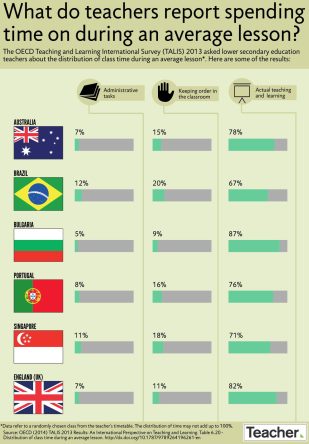Teachers and school leaders across the globe have shared their views on issues affecting their profession in the 2018 OECD Teaching and Learning International Survey (TALIS).
TALIS is a large-scale survey of teachers and school leaders that generates internationally comparable information on the state of the teaching profession.
Participants were asked for their views on a range of topics, including how much time they spend on teaching and classroom management during a typical lesson, their assessment practices and their school's approach to innovation.
About 260 000 teachers from 15 000 schools across 48 countries and economies – including Australia – took part in this cycle, representing an estimated population of more than 8 million teachers.
OECD Director of Education and Skills, Andreas Schleicher says TALIS establishes a teacher's perspective on how teaching and learning can be organised to achieve the best outcomes for students.
‘The views of teachers as expressed in TALIS tell us a lot about the gap between pedagogical vision and practice, and between professional aspirations and a still highly industrial organisation of work,' he says.
Much like the first two cycles of TALIS in 2008 and 2013, the 2018 cycle of TALIS uses questionnaires administered to teachers and principals to gather data. The survey is designed for lower secondary education teachers and school leaders of mainstream schools. It aims to have their voices heard all the way up to the policy level.
Professionalism is analysed in TALIS 2018 by looking at five pillars: the knowledge and skills required to teach; the perceived prestige of the profession; career opportunities; the collaborative culture among teachers; and the level of professional responsibility and autonomy of teachers and school leaders.
The first report from this cycle, Teachers and School Leaders as Lifelong Learners, was published overnight. It addresses the first pillar – examining how teachers apply their knowledge and skills in the classroom. Here, we take a closer look at some of the main findings.
Knowledge and skills required to teach
TALIS 2018 examined the practices that teachers use in the classroom and how they have changed over time. The report notes that at least two-thirds of teachers surveyed rely on practices that centre on managing the class and ensuring clarity of instruction.
‘What is less prevalent, however, is the use of practices that involve student cognitive activation (getting students to evaluate information and apply knowledge in order to solve a problem), despite their high potential leverage on student learning. Only around half of teachers adopt this approach,' the report says.
Teaching time
OECD countries participating in TALIS reported that 78 per cent of a typical lesson is dedicated to teaching (the equivalent of 47 minutes of a 60 minute lesson), 13 per cent of classroom time on keeping order in the classroom (the equivalent of 8 minutes) and 8 per cent on administrative tasks (the equivalent of 5 minutes).
Assessment
Teachers participating in TALIS 2018 were asked about their assessment practices in the classroom. Seventy-nine per cent of teachers report assessing their students' progress by observing them and providing immediate feedback, while 77 per cent of teachers report administering their own assessment to their students. Meanwhile, 41 per cent of teachers allow students to evaluate their own progress.
Innovative practices
TALIS 2018 also looked at capacity for innovation – both at a team and organisational level. The results show that the vast majority of teachers and school leaders report that their schools are open to innovative practices. On average across the OECD, 78 per cent of teachers report that they and their colleagues help each other to implement new ideas.
How Australia compares to the OECD
Australia has participated in all three cycles of TALIS. In this cycle, the results show that a teaching career was the first choice for 58 per cent of Australian teachers, compared to 67 per cent of teachers from OECD countries. At least 93 per cent of Australian teachers say the opportunity to influence children's development or contribute to society was as a major motivation for entering the profession.
When it comes to student assessment and feedback, 89 per cent of Australian teachers report routinely assessing their students' progress by observing them and providing immediate feedback (OECD average 79 per cent).
Meanwhile, 74 per cent of teachers reported administering their own assessments to their students (OECD average 77 per cent) and 44 per cent of teachers frequently let students evaluate their own progress (OECD average 41 per cent).
On the issue of how time is spent during a typical lesson, Australian educators spend 78 per cent of classroom time on actual teaching and learning, which is the same as the OECD average.
When asked about the quality of the training they received, 92 per cent of teachers in Australia report that it had a positive impact on their teaching practice. The OECD average was 82 per cent.
Early career teachers – how prepared are they?
Early career teachers expressed their views on their first experiences in the classroom, as well as their initial training. The results show that teaching was the first career choice for two out of three teachers from OECD countries, although this is true for only 59 per cent of male teachers compared to 70 per cent of female teachers.
The opportunity to contribute to children's development and society was a major motivation for joining the profession for 90 per cent of teachers.
Data from TALIS 2018 show that early career teachers tend to work in challenging schools with higher concentrations of students from socioeconomically disadvantaged backgrounds. On average across the OECD, 22 per cent of early career teachers said they would change to another school if it were possible.
Upon completing their initial preparation, 38 per cent of early career teachers participated in formal or informal induction processes at their first school, and only 22 per cent were assigned a mentor.
‘Novice teachers feel less confident in their ability to teach, particularly in their classroom management skills and their capacity to use a wide range of effective instructional practices,' the report says.
‘This result could be linked to the amount of time they have available for planning and teaching their classes, as novice teachers spend less time in actual teaching than more experienced teachers.'
Professional development and its impact
TALIS 2018 data show annual participation in professional development is almost universal among both teachers and school leaders. In fact, 94 per cent of teachers and nearly 100 per cent of principals participated in at least one type of professional development in the 12 months prior to the survey. It also asked teachers to describe the characteristics of the training they deemed impactful.
‘Attending courses and seminars outside of school is one of the most popular types of professional development for teachers – more than 70 per cent participate in this kind of training,' the report reads.
‘Only 44 per cent of teachers, however, participate in training based on peer learning and networking, despite the fact that collaborative learning is one of the aspects of training that teachers in TALIS identify as the most impactful.'
According to teachers, there are still some areas of professional development that they need further support in, including developing advanced ICT skills, and with teaching in multicultural settings or with students with special needs.
Eighty-two per cent of teachers report that the training had a positive impact on their teaching practice. It also led to higher levels of self-efficacy and job satisfaction.
Visit the OECD website to read the Teachers and School Leaders as Lifelong Learners report.
ACER will publish a national report, with detailed analysis of results within Australia, later in 2019.



